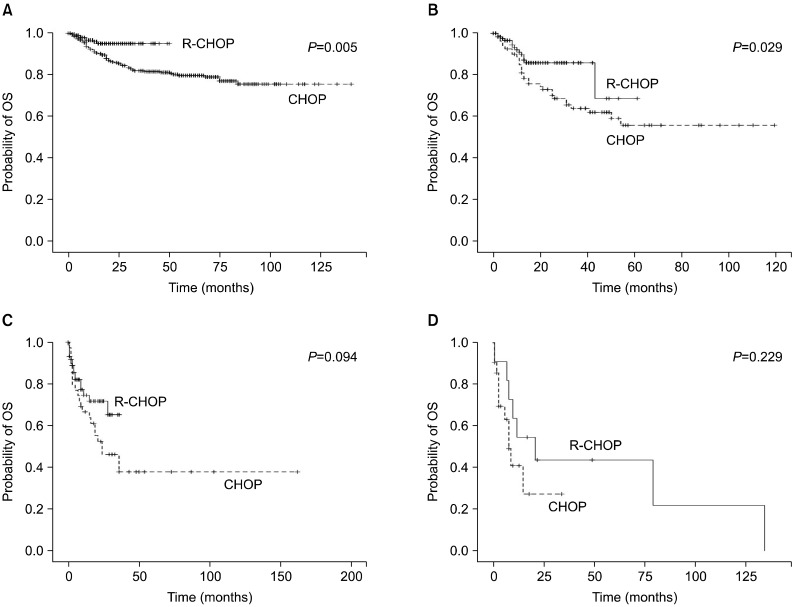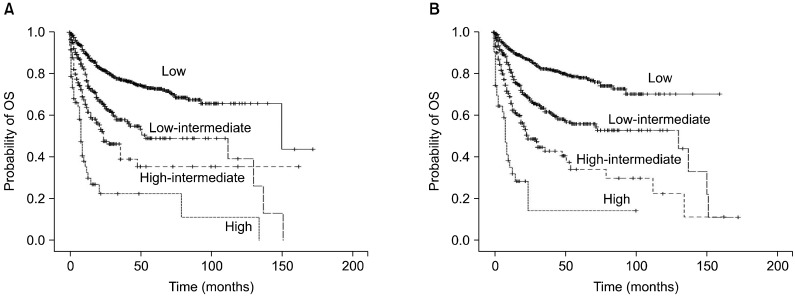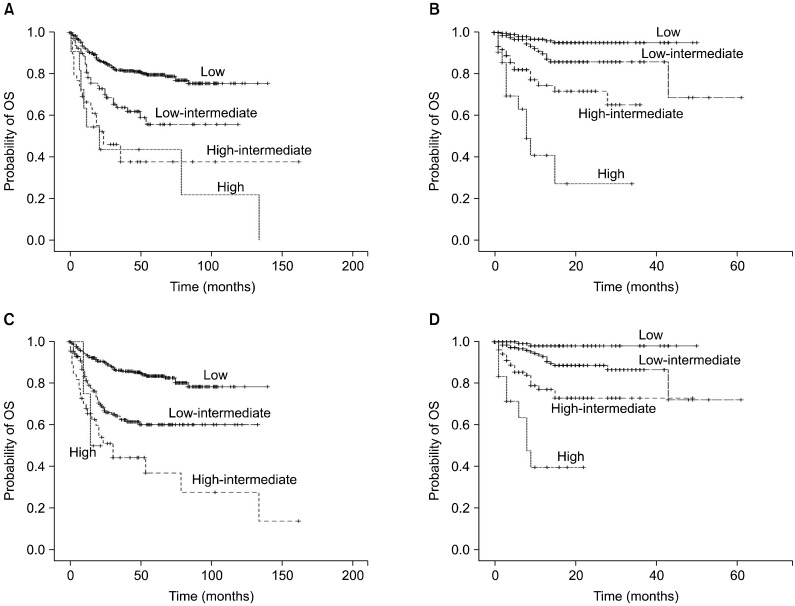Clinical features and survival outcomes of patients with diffuse large B-cell lymphoma: analysis of web-based data from the Korean Lymphoma Working Party Registry
- Affiliations
-
- 1Department of Internal Medicine, Inha University Hospital, Inha University College of Medicine, Incheon, Korea. cskimmd@inha.ac.kr
- 2Department of Internal Medicine, Severance Hospital, Yonsei University College of Medicine, Seoul, Korea.
- 3Department of Internal Medicine, Asan Medical Center, Ulsan University College of Medicine, Seoul, Korea.
- 4Department of Internal Medicine, Samsung Medical Center, Sungkyunkwan University School of Medicine, Seoul, Korea.
- 5Department of Internal Medicine, Chonbuk National University Medical School & Hospital, Jeonju, Korea.
- 6Department of Internal Medicine, Seoul National University Bundang Hospital, Seoul National University College of Medicine, Seongnam, Korea.
- 7Department of Internal Medicine, Kosin University Gospel Hospital, Kosin University College of Medicine, Pusan, Korea.
- 8Department of Internal Medicine, Haeundae Paik Hospital, Inje University College of Medicine, Pusan, Korea.
- 9Department of Internal Medicine, Konkuk University Medical Center, Konkuk University College of Medicine, Seoul, Korea.
- 10Department of Internal Medicine, Seoul National University Hospital, Seoul National University College of Medicine, Seoul, Korea.
- 11Department of Internal Medicine, Soonchunhyang University Hospital, Soonchunhyang University College of Medicine, Seoul, Korea.
- 12Department of Internal Medicine, Ajou University School of Medicine, Suwon, Korea.
- 13Korean Society of Hematology Lymphoma Working Party, Korea.
- KMID: 2172909
- DOI: http://doi.org/10.5045/br.2013.48.2.115
Abstract
- BACKGROUND
This study aimed to survey the clinical spectrum of diffuse large B-cell lymphoma (DLBCL) in terms of epidemiology, pathologic subtypes, stage, and prognostic index as well as treatment outcomes.
METHODS
In 2007-2008, 13 university hospitals evenly distributed in the Korean peninsula contributed to the online registry of DLBCL at www.lymphoma.or.kr and filed a total of 1,665 cases of DLBCL recorded since 1990.
RESULTS
Our analysis showed a higher prevalence of DLBCL in male than in female individuals (M:F=958:707), and extranodal disease was more common than primary nodular disease (53% vs. 47%). Among the 1,544 patients who had been treated with CHOP (cyclophosphamide, doxorubicin, vincristine, and prednisone) or rituximab-CHOP (R-CHOP) therapy with or without radiation, 993 (63.9%) were alive, with 80% free of disease, 417 were dead (26.8%), with 13% free of disease, and 144 (9.3%) were lost to follow-up, with 23% free of disease. Age below 60 years, stage at diagnosis, international prognostic index (IPI) score regardless of age, and addition of rituximab to CHOP therapy in low- and low-intermediate-risk groups according to IPI scores significantly increased survival duration.
CONCLUSION
The epidemiology, clinical spectrum, and biological behavior of DLBCL in Korea are similar to those observed in Western countries, and the advent of rituximab improved survival.
MeSH Terms
-
Antibodies, Monoclonal, Murine-Derived
Antineoplastic Combined Chemotherapy Protocols
B-Lymphocytes
Cyclophosphamide
Doxorubicin
Female
Hospitals, University
Humans
Korea
Lost to Follow-Up
Lymphoma
Lymphoma, B-Cell
Male
Prednisolone
Prevalence
Vincristine
Rituximab
Antibodies, Monoclonal, Murine-Derived
Antineoplastic Combined Chemotherapy Protocols
Cyclophosphamide
Doxorubicin
Prednisolone
Vincristine
Figure
Cited by 3 articles
-
Baseline renal function as a prognostic indicator in patients with newly diagnosed diffuse large B-cell lymphoma
Junshik Hong, Sojung Lee, Gayoung Chun, Ji Yong Jung, Jinny Park, Jeong Yeal Ahn, Eun Kyung Cho, Dong Bok Shin, Jae Hoon Lee
Blood Res. 2016;51(2):113-121. doi: 10.5045/br.2016.51.2.113.Clinical impact of CD5 expression in Korean patients with diffuse large B-cell lymphoma
Hyun-Young Kim, Mi-Ae Jang, Hee-Jin Kim, Seok Jin Kim, Won Seog Kim, Sun-Hee Kim
Blood Res. 2017;52(3):193-199. doi: 10.5045/br.2017.52.3.193.Diagnostic Accuracy and Prognostic Relevance of Immunoglobulin Heavy Chain Rearrangement and 18F-FDG-PET/CT Compared With Unilateral Bone Marrow Trephination for Detecting Bone Marrow Involvement in Patients With Diffuse Large B-Cell Lymphoma
Mihee Kim, Seo-Yeon Ahn, Jae-Sook Ahn, Ga-Young Song, Sung-Hoon Jung, Je-Jung Lee, Hyeoung-Joon Kim, Jun Hyung Lee, Myung-Geun Shin, Sang Yun Song, Deok-Hwan Yang
J Korean Med Sci. 2021;37(1):e2. doi: 10.3346/jkms.2022.37.e2.
Reference
-
1. Morton LM, Wang SS, Devesa SS, Hartge P, Weisenburger DD, Linet MS. Lymphoma incidence patterns by WHO subtype in the United States, 1992-2001. Blood. 2006; 107:265–276. PMID: 16150940.
Article2. Swerdlow SH, Campo E, Harris NL, editors. WHO Classification of tumours of haematopoietic and lymphoid tissues. 4th ed. Lyon, France: IARC;2008.3. Kim JM, Ko YH, Lee SS, et al. WHO Classification of malignant lymphomas in Korea: report of the third nationwide study. Korean J Pathol. 2011; 45:254–260.
Article4. Coiffier B, Lepage E, Briere J, et al. CHOP chemotherapy plus rituximab compared with CHOP alone in elderly patients with diffuse large-B-cell lymphoma. N Engl J Med. 2002; 346:235–242. PMID: 11807147.
Article5. Pfreundschuh M, Trümper L, Osterborg A, et al. CHOP-like chemotherapy plus rituximab versus CHOP-like chemotherapy alone in young patients with good-prognosis diffuse large-B-cell lymphoma: a randomised controlled trial by the MabThera International Trial (MInT) Group. Lancet Oncol. 2006; 7:379–391. PMID: 16648042.6. Pfreundschuh M, Schubert J, Ziepert M, et al. Six versus eight cycles of bi-weekly CHOP-14 with or without rituximab in elderly patients with aggressive CD20+ B-cell lymphomas: a randomised controlled trial (RICOVER-60). Lancet Oncol. 2008; 9:105–116. PMID: 18226581.7. Krause SW, Gerken M, Andreesen R, Hofstädter F, Klinkhämmer-Schalke M. Treatment of B cell lymphoma with chemotherapy plus rituximab: a survival benefit can be demonstrated in the routine data of a regional cancer registry. Ann Hematol. 2012; 91:561–570. PMID: 22200972.
Article8. Cheson BD, Horning SJ, Coiffier B, et al. NCI Sponsored International Working Group. Report of an international workshop to standardize response criteria for non-Hodgkin's lymphomas. J Clin Oncol. 1999; 17:1244. PMID: 10561185.
Article9. Feugier P, Van Hoof A, Sebban C, et al. Long-term results of the R-CHOP study in the treatment of elderly patients with diffuse large B-cell lymphoma: a study by the Groupe d'Etude des Lymphomes de l'Adulte. J Clin Oncol. 2005; 23:4117–4126. PMID: 15867204.
Article10. Komrokji RS, Al Ali NH, Beg MS, et al. Outcome of diffuse large B-Cell lymphoma in the United States has improved over time but racial disparities remain: review of SEER data. Clin Lymphoma Myeloma Leuk. 2011; 11:257–260. PMID: 21658652.
Article11. Guyomard S, Salles G, Coudurier M, et al. Prevalence and pattern of antinuclear autoantibodies in 347 patients with non-Hodgkin's lymphoma. Br J Haematol. 2003; 123:90–99. PMID: 14510947.
Article12. Kang J, Cho JH, Suh CW, et al. High prevalence of hepatitis B and hepatitis C virus infections in Korean patients with hematopoietic malignancies. Ann Hematol. 2011; 90:159–164. PMID: 20821327.
Article13. Oh MD, Park SW, Kim HB, et al. Spectrum of opportunistic infections and malignancies in patients with human immunodeficiency virus infection in South Korea. Clin Infect Dis. 1999; 29:1524–1528. PMID: 10585807.
Article14. Lee EH, Han MA, Lee HY, Jun JK, Choi KS, Park EC. Liver cancer screening in Korea: a report on the 2008 National Cancer Screening Programme. Asian Pac J Cancer Prev. 2010; 11:1305–1310. PMID: 21198282.15. Møller MB, Pedersen NT, Christensen BE. Diffuse large B-cell lymphoma: clinical implications of extranodal versus nodal presentation--a population-based study of 1575 cases. Br J Haematol. 2004; 124:151–159. PMID: 14687024.16. López-Guillermo A, Colomo L, Jiménez M, et al. Diffuse large B-cell lymphoma: clinical and biological characterization and outcome according to the nodal or extranodal primary origin. J Clin Oncol. 2005; 23:2797–2804. PMID: 15728226.
Article17. Yang BY, Yong WB, Zhu J, et al. Clinical characteristics and prognosis of diffuse large B-cell lymphoma. Zhonghua Zhong Liu Za Zhi. 2005; 27:174–176. PMID: 15946571.18. Sehn LH, Berry B, Chhanabhai M, et al. The revised International Prognostic Index (R-IPI) is a better predictor of outcome than the standard IPI for patients with diffuse large B-cell lymphoma treated with R-CHOP. Blood. 2007; 109:1857–1861. PMID: 17105812.
Article19. Ziepert M, Hasenclever D, Kuhnt E, et al. Standard international prognostic index remains a valid predictor of outcome for patients with aggressive CD20+ B-cell lymphoma in the rituximab era. J Clin Oncol. 2010; 28:2373–2380. PMID: 20385988.
- Full Text Links
- Actions
-
Cited
- CITED
-
- Close
- Share
- Similar articles
-
- Review of the clinical research conducted by the Consortium for Improving Survival of Lymphoma of the Korean Society of Hematology Lymphoma Working Party
- Relapse of Ocular Lymphoma following Primary Testicular Diffuse Large B-cell Lymphoma
- The Expression of p16 in Diffuse Large B-cell Lymphoma and Its Prognostic Implications
- Successful Salvage Treatment for Isolated Brain Parenchymal Relapse due to Diffuse Large B Cell Lymphoma
- Relationships among Hepatitis C Virus, Hepatocellular Carcinoma, and Diffuse Large B Cell Lymphoma: A Case Report




